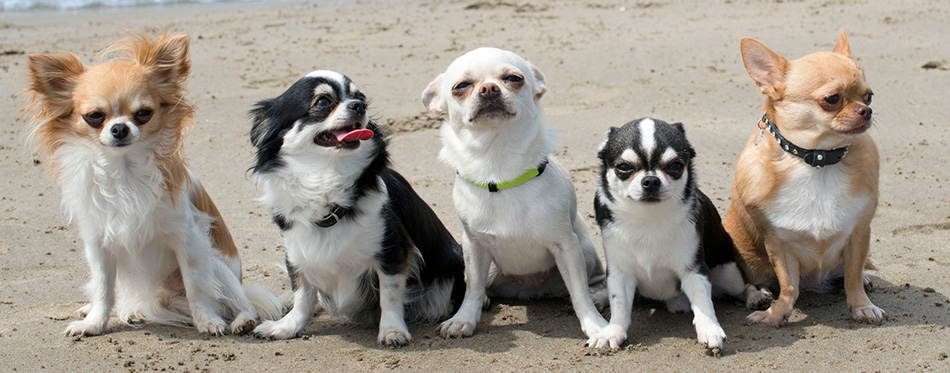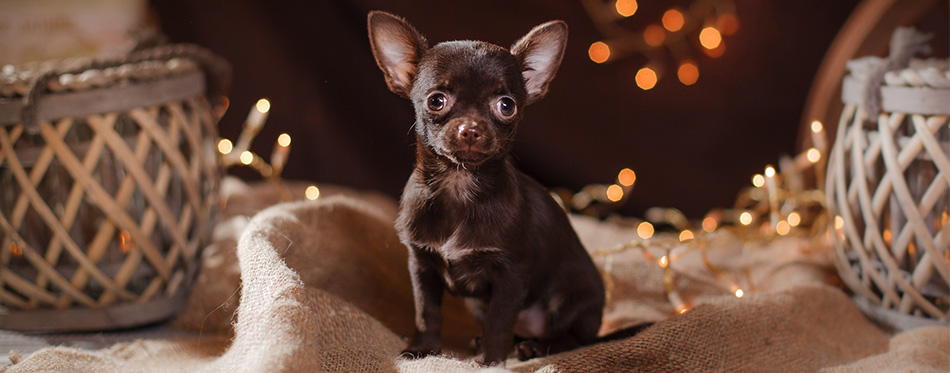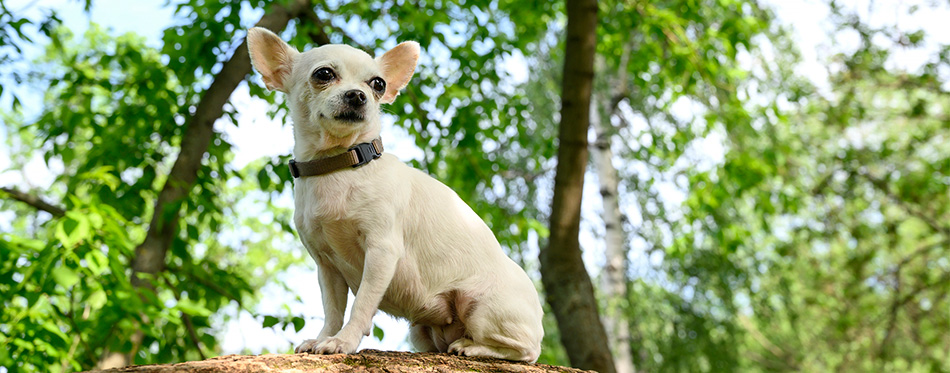History
Chihuahuas were popularized by Paris Hilton in the early 2000s as being a “handbag dog”, as they were small enough to fit in your handbag and could be used as a living accessory. However, chihuahuas go way further back in history than belonging to celebrities that only used them as a way of garnering attention.
The breed originally was born out of Mexico, and was named after the state of Chihuahua in Mexico. It is the smallest breed of dog and was recorded in 1520 as being bred as food for larger dogs, or as “living hot-water bottles” to be used when ill or injured. Although not originally respected as a domesticated dog breed, chihuahuas grew to be a favoured pet type among those initially using them for other reasons.
Chihuahuas were not respected as a proper dog breed until 1904, when the American Kennel Club (AMC) recognized them officially. After this time, proper breed statistics were developed and kennel clubs began judging them at dog shows. There are two types of Chihuahuas recognized at the AMC – the Smooth Coat (short-haired) and the Long Coat (long-haired). They are considered different breeds and are judged as such.
Breed standards for Chihuahuas have changed drastically since 1904. In history, chihuahuas were measured at a standard 6-7 inches in length and 30-32 cm tall. However, in recent years, it has been decided that chihuahuas vary greatly in their height and length, and so it can be hard to fit them into a specific standard. Pet chihuahuas (those that are not used for dog shows) can vary even more than the official standards, making it even more difficult to narrow it down. This means that chihuahuas are a more troublesome dog for veterinarians to understand and diagnose with medical conditions correctly.
A similar trait that these small dogs carry from their original roots is living in the dog dens of Mexico and burrowing food and items they’ve found in the dens. Chihuahuas can be seen creating dens out of their dog beds and blankets, as well as bringing kibbel and dog treats in with them. If they have puppies, they may bring the puppies into the den to “hide” them from the humans in the home and hoard food to keep themselves healthy to feed the puppies. Due to this trait, some chihuahuas love spending time in the dark, where they can feel the most protected.
Though their history is unclear, chihuahuas are a great dog to have in the home, as they are small and are the perfect animal to have in an apartment that may not otherwise allow bigger dogs. If you’re raising a Chihuahua for the intention of putting it in dog shows, it may be more difficult to create the “perfect” version of it, but otherwise, they are just like any other dog.

Who Are the Parents
When chihuahuas are not purebred (like they can be when you buy them at an animal shelter or from a friend), they can be several breeds mixed into a single, small dog.
Some of the more common breeds that breed with Chihuahuas are Pomeranians (a small, fluffy dog), Shih-Tzu (a small, long-haired dog), a Jack-Russell Terrier (a short, muscular dog), or a Boston Terrier (a short-nosed, stubby dog). To be sure which one is mixed with your Chihuahua, you can consult a veterinarian, who can make an educated guess. Otherwise, you can have several DNA tests done, either online or through your local vet clinic. They will take blood samples from your Chihuahua-mix and return them to you within a couple weeks, so you can find out if you own a PomChi (Pomeranian-Chihuahua) or JackChi (Jack-Russell Terrier-Chihuahua).
If you’re looking to have a 100% purebred chihuahua to compete in dog shows, it is best to seek out a breeder who is credited in the dog breeder community or who has been certified by the American Kennel Club or UK Kennel club. Be aware that it can be difficult to find a completely purebred chihuahua, as the breed itself has a blurry background and it is not clear what the true “breed” is. As always, it is best to consult with a professional to handle the matter seriously.
Quick Facts
If you’re considering owning a Chihuahua, there are a few quick and simple facts you should take into consideration so that you’re fully educated on the breed.
Here are 10 facts to help you feel more comfortable with adopting a Chihuahua:
- Chihuahuas have some of the longest life spans of all the recognized dog breeds, being able to live up to 14-18 years old. This means you can ensure that your companion stays your companion for a long time. It also means that if you wanted a dog for a short time while your children still live at home, perhaps a Chihuahua is not the right one for you.
- It is common for Chihuahuas to develop phobias, like humans can. Some of the more usual phobias they deal with are a fear of being home alone, traffic, buses, and dogs that they haven’t met before. This is an important factor to consider when adopting a Chihuahua, as you may have to make accomodations for it’s mental health. Though it isn’t hard to be sensitive to the well-being of your loved family dog.
- Chihuahuas make for fantastic service dogs. They have been recorded in history as being able to accurately lead the blind and provide emotional support as a therapy dog. This means your future potential Chihuahua can be your service dog, if you or a loved one has been looking for the right one for your family. Their small size is also a bonus when needed to bring your service dog on a train or aeroplane.
- Some breeds try to sell Chihuahuas as a “teacup Chihuahua” – however, this doesn’t exist at all! The name itself is redundant. All Chihuahuas are the same small size and do not come in sizes smaller than have been presented by the breed. If a breeder is selling this to you, it is a scam and should be avoided and reported to the local dog breeding jurisdiction.
- Chihuahuas are prone to getting easily cold and can take to shivering if their body temperature isn’t regulated. It can be hard to get them to live comfortably in cold climates (especially if you’re spending a lot of time outside). These tiny dogs should not be outside in cold temperatures for longer than 20 minutes and is kept supervised on a leash or in a small, enclosed area for it’s own safety. Otherwise, the dog is at risk of frostbite and suffocation in tall snow.
- When buying a Chihuahua, you need to watch out for not only “teacup” sellers, but also those selling you rats! Yes, actual rats. Some particularly sneaky sellers have sold small rat pups as “Chihuahua puppies” and got away with it until the rat got older. There is one documented case of this happening in South America, in which a woman paid $500 for what she thought was a Chihuahua puppy – but turned out to be a rat.
- Though people like to joke that Chihuahuas are lesser because of their size in comparison to German Shepherds or Labradors, Chihuahuas actually have the largest sized brain when comparing body-to-brain size ratio. They may not be as dumb as some people like to portray them – even if certain celebrities started them out on that stereotype originally.
- Chihuahuas are extremely active breeds and have a lot of energy that can be hard to manage if they are not regularly walked. They need to be walked at least 30 minutes, twice per day, in order to make sure they are not barking wildly or tearing up furniture inside of your home. If you don’t have that time to devote to your new Chihuahua puppy, it is worth looking into putting it in a dog daycare or hiring a local dog walker.
- You need to be extra careful with Chihuahuas during and after their puppy stage, as their heads have a “molera” on them that may not go away after birth. A molera is a soft spot on top of the skull that can usually be seen on human infants and Chihuahuas at all ages and is at risk for serious damage if you’re not careful. The breed standard doesn’t have a preference for this spot, so unfortunately, you may not be able to breed it out.
- According to a study done by the University of Georgia, the top 3 leading causes of death for Chihuahuas are cardiovascular disease, trauma, and infection. This means that you need to watch out when your new little Chihuahua puppy is in an environment that may cause any of the above problems. If you’re bringing the Chihuahua into a home with children, you need to teach them about how to avoid causing trauma to the dog by accident with toys or equipment (such as bicycles).

Things You Should Know
Training
When training Chihuahuas, it’s important to remember that these dogs are far more dominant and possessive than they are submissive, so they will be reluctant to listen to your commands. However, that doesn’t mean that they can’t be trained (especially as service dogs). To train Chihuahuas, you need to keep a few things in mind. The first thing is that you need to show a fully authoritarian attitude. If the Chihuahua senses that you are weak at all, it will take advantage of that. Keep steadfast on your rules and stick to them. The second thing is that Chihuahuas can easily be socialized with other dogs, but it has to be with dogs that are calm and will not respond in aggression. As previously mentioned, Chihuahuas can easily develop phobias and a single bad experience with another dog can ruin their experience with other dogs for life. So, in training these small dogs, remember to keep their environment calm, and use authority in your tone and body language.
Feeding
When it comes to feeding a Chihuahua, you need to know that their stomachs are extremely sensitive and can be largely affected by the timing of their feedings. To prevent causing distress and rushing to the vet, the best way to feed your Chihuahua is through a regular schedule of small, frequent meals at the same times. This food should be mostly chemical-free and the right balance of nutrition. You should be feeding your Chihuahua between a ½ cup to 1 and ⅓ cup of food per day, but it may vary depending on the size of your dog and the type of food you’re feeding it. The best person to ask would be your veterinarian, who also may be able to help with any of your Chihuahua’s stomach sensitivities. If you aren’t sure about feeding your Chihuahua regular kibble or wet dog food, you may also choose to made home cooked meals for your dog. This way, you know there are no additives and you know every single ingredient that went into creating it. There are great recipes online tailored to the needs of Chihuahuas and their nutritional needs.
For more guides on choosing the right dog food, you may wish to check out our reviews of the best dry dog food, organic dog food, vegan dog treats, dog food toppers and puppy food.
Grooming
In order to keep your Chihuahua looking it’s best, it’s a good idea to get it regularly groomed. Whether you do this yourself at home or get it done by a dog breeder, it is good for your Chihuahua’s health to get it looked after physically. Due to Chihuahuas usually being long-haired, it’s important to bathe them at least every 3 months and brush them often to avoid mats in their fur. Brushing out mats will also be a great opportunity to remove ticks or fleas, if you live somewhere where those are an issue. When you’re done bathing and brushing your Chihuahua, it is best to let them air-dry in the sun (when possible), as normal hair dryers can be highly frightening for such a small dog. You may also choose to gently dry them with a towel, being sure to pat down their stomach and molera (soft spot) on the tops of their skulls.
For more help on dog grooming, you may wish to read our guides on the best dog thinning shears, dog shedding brush, dog clippers, dog paw washers, puppy shampoo and dog shampoo.
Health
As with feeding and grooming, keeping on top of the health of our Chihuahua is integral in allowing it to live to it’s full life span of 14-18 years. The best way to look after your small dog’s health is to keep it vaccinated from the puppy stage onward, then monitor it’s health and the environment it lives in. Due to how small the breed is, the Chihuahua can easily gain too much weight for it’s size and will struggle with being even slightly overweight. To make sure it doesn’t get too overweight, do not overfeed it with dog treats and walk it regularly at a moderate pace. It’s also a great idea to play with your Chihuahua outside and teach it to play “fetch” to keep it running and active. Another way to ensure your Chihuahua’s health is cleaning and brushing your Chihuahua’s teeth on a regular basis. This particular breed is vulnerable to tooth issues and unbrushed teeth can lead to severe infections and possible fatality. Find out more about dog toothbrushes and dog toothpaste here.

Temperament
The temperament of the Chihuahua is something that keeps people hesitant to bringing the breed into their home. Society often likens the Chihuahua to being the “aggressive breed” to humans in comparison to bigger, more gentle dogs. However, these dogs don’t need to be villainized, as their fearlessness doesn’t stop them from being loveable, cuddly family home dogs. It is important to note that the temperament of the Chihuahua is mostly good, except for when it comes to other canines. Chihuahuas have a difficult time developing positive relationships with other dogs due to their natural territorial nature. This doesn’t mean that Chihuahuas can never get along with other dogs – it just means that they will take longer to adjust (if they do at all).
Ultimately, Chihuahuas are a great dog breed to have in your home as a personal dog, show dog, or service dog breed. They are fiercely loyal and will not hesitate to protect you from danger. Some Chihuahuas have even been recorded protecting their owners from larger animals while on hikes – such as bears or cougars. The rest of society may make fun of you for it (thanks, early-2000s celebrities!), but owning a Chihuahua will make your home a happier place to be – and your family will be grateful for it.
As long as you treat your Chihuahua with love, compassion, and respect (and not just as a “handbag dog”), you will have a great canine partner for years to come.
Source:
- Chihuahua – AKC

